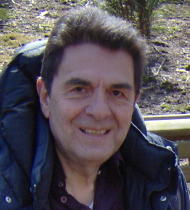Biography:Theodosios Pavlidis
Theodosios Pavlidis | |
|---|---|
 | |
| Born |
September 8, 1934 Thessaloniki, Greece |
| Nationality | Greek |
| Citizenship | United States |
| Alma mater | |
| Awards |
|
| Scientific career | |
| Fields |
|
| Institutions |
|
| Thesis | Analysis and Synthesis of Pulse Frequency Modulation Feedback Systems (1964) |
| Doctoral advisor | Eliahu I. Jury |
| Doctoral students | John Mylopoulos |
| Website | www |
Theodosios Pavlidis (Greek: Θεοδόσιος Παυλίδης; born September 8, 1934 in Thessaloniki) is a computer scientist and Distinguished Professor Emeritus of Computer Science at the State University of New York, Stony Brook.[1]
Education
Pavlidis studied at the National Technical University of Athens, where in 1957 he received his Diploma in Mechanical and Electrical Engineering degree. He continued to study at the University of California, Berkeley, where he received his MS in Electrical Engineering in 1962 and his PhD in Electrical Engineering in 1964.[2][3][4]
Career
Pavlidis taught at Princeton University, starting as an assistant professor in 1964, promoted to associate professor in 1968[5] and full professor in 1975.[6] In 1980, he joined AT&T Bell Laboratories in Murray Hill, New Jersey as a Member of Technical Staff.[7] While at Bell Labs, in 1982, he was appointed Senior Editor of the IEEE Transactions on Pattern Analysis and Machine Intelligence (PAMI)[8] and held that position through 1986. Pavlidis resumed teaching in 1986, first as a Leading Professor, and then as a distinguished professor in 1995, becoming emeritus in 2001.[1][4]
Pavlidis conducted fundamental research in several computer software technology areas, including pattern recognition, image analysis, picture editing, OCR, computer vision, and barcodes. He contributed to the PDF417 two-dimensional barcode ISO standard, allowing for the barcode itself to have very high information density and error correction.[4][9] His work in computer vision resulted in an algorithm that could scan barcodes that are poorly printed or defaced/dirty.[10][11]
Pavlidis has published several books, and numerous articles and papers in leading engineering journals and conference proceedings.[12][13] He is also a named inventor on 15 U.S. issued patents.[14]
Additional aspects of Pavlidis' career may be found in the sidebar of his IAPR profile.[15]
Honors and awards
- 1979: Fellow of the IEEE[16]
- 1986: IEEE Computer Society Meritorious Service Certificate for contributions as Editor-in-Chief of PAMI[17]
- 1994: Fellow of the IAPR for contributions to computer graphics and image processing, and for service to the IAPR[18]
- 1996: IEEE Computer Society Golden Core Award[19]
- 2000: IAPR King-Sun Fu Prize for fundamental contributions to the theory and methodology of structural pattern recognition[20]
Books
- Biological Oscillators: Their Mathematical Analysis. Academic Press, 1973.
- Structural Pattern Recognition. Springer-Verlag, 1977.
- Algorithms for Graphics and Image Processing. Computer Science Press, 1982.
- Interactive Computer Graphics in X. PWS Publishing, 1995.
- Fundamentals of X Programming. Kluwer Academic/Plenum Publishers, 1999.
References
- ↑ 1.0 1.1 "SBU - Computer Science Department - Theo Pavlidis". https://www.cs.stonybrook.edu/people/faculty/TheoPavlidis.
- ↑ "Ph.D. Dissertations in EECS at UC Berkeley 1964". https://www.eecs.berkeley.edu/Pubs/Dissertations/Years/1964.html.
- ↑ "The Mathematics Genealogy Project - Theodosios Pavlidis". http://www.genealogy.ams.org/id.php?id=82043.
- ↑ 4.0 4.1 4.2 "King-Sun Fu Prize. IAPR Newsletter, Vol. 24, No. 4, Autumn 2000". http://www.theopavlidis.com/technology/cv/KSFu_prize.pdf.
- ↑ "Faculty Promotions. Princeton Alumni Weekly, Vol. 68, May 7, 1968, p. 99". 1967. https://books.google.com/books?id=OxlbAAAAYAAJ&pg=RA2-PA99.
- ↑ "The Faculty. Princeton Alumni Weekly, Vol. 75, May 6, 1975, p.74". 1974. https://books.google.com/books?id=JRVbAAAAYAAJ&pg=PA74-IA17.
- ↑ "Alumni of the Bell Labs Computing Sciences Research Center". http://spinroot.com/gerard/1127_alumni.html.
- ↑ "Opinion". IEEE Transactions on Pattern Analysis and Machine Intelligence PAMI-4: 1. 1982. doi:10.1109/TPAMI.1982.4767187.
- ↑ "NSF Researchers Improve Barcode Scanners; Advances Lead to Widespread Use of the Technology". https://www.nsf.gov/discoveries/disc_summ.jsp?cntn_id=100278.
- ↑ Joseph, E.; Pavlidis, T. (1993). "Deblurring of bilevel waveforms". IEEE Transactions on Image Processing 2 (2): 223–35. doi:10.1109/83.217225. PMID 18296210. Bibcode: 1993ITIP....2..223J.
- ↑ Joseph, E.; Pavlidis, T. (1994). "Bar code waveform recognition using peak locations". IEEE Transactions on Pattern Analysis and Machine Intelligence 16 (6): 630–640. doi:10.1109/34.295907.
- ↑ {{Google Scholar id}} template missing ID and not present in Wikidata.
- ↑ {{DBLP}} template missing ID and not present in Wikidata.
- ↑ "Theodosios Pavlidis. USPTO Patent Database". http://patft.uspto.gov/netacgi/nph-Parser?Sect1=PTO2&Sect2=HITOFF&u=%2Fnetahtml%2FPTO%2Fsearch-adv.htm&r=0&p=1&f=S&l=50&Query=IN%2F%28%22pavlidis%2C+theodosios%22+OR+%22pavlidis%2C+theo%22%29&d=PTXT.
- ↑ "Getting to know... Theo Pavlidis, IAPR Fellow. IAPR Newsletter, Vol. 34, No. 1, January, 2012.". http://www.iapr.org/members/newsletter/Newsletter12-01/index_files/Page751.htm.
- ↑ "IEEE Fellows Directory". https://www.ieee.org/membership_services/membership/fellows/fellowsDirectory.html#.
- ↑ "IEEE Computer Society Meritorious Service Certificate". https://www.computer.org/web/awards/meritorious-service.
- ↑ "IAPR Fellows". http://www.iapr.org/fellowsandawards/?ar=1#p.
- ↑ "IEEE Computer Society Golden Core". https://www.computer.org/web/awards/golden-core#1996b.
- ↑ "IAPR - IAPR Awards". http://www.iapr.org/fellowsandawards/awards_kingsunfu.php.

